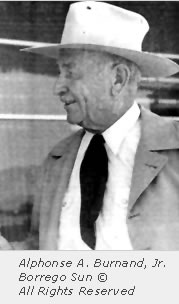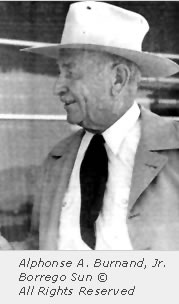He was born in 1896 in Colorado, the son of a miner. The family moved to Santa Monica where Burnand grew up and attended the University of California at Davis, majoring in agriculture. Following graduation he went to Delano in California's Central Valley, the largest table grape producing area in the state. After working in the fields, he soon acquired his own vineyard, and met the DiGiorgio family, at the time the largest grape growers in the world.
Alphonse Burnand attended Stanford, as did his Olympic skipper, Owen Churchill. Burnand graduated in 1914 and later started his own business as an investment broker. Burnand and Churchill sailed together frequently, were close friends, and also went into business together as fruit and vegetable brokers in the San Joaquin Valley.
Alphonse was also an American sailor who competed in the 1932 Summer Olympics. In 1932 he was a crew member of the American boat Angelita which won the gold medal in the 8 metre class.
Around 1933, Burnand made his first trip to the Borrego Valley looking for areas where crops would ripen early. The first crops to market would command a higher price and potentially greater profit. In the Borrego Valley grapes would be ready to pick several weeks ahead of other growing areas. The grapes would usually be sent to markets in New York.
In 1936 Burnand purchased an interest in the Coyote Canyon Ranch (Doc Beaty's old canyon ranch), to be followed by the de Anza Ranch. The heat, high winds and winter cold made growing grapes in Borrego difficult - but despite some failures Burnand had spent enough time in the Valley to see its potential as a resort. He began buying up railroad in-holdings in the Park area, and trading them with the State for valley land as well as picking up property from tax sales and homesteaders wanting out. His holdings grew to about 17,000 acres.
In 1945, Burnand announced plans for a resort community. The San Diego Union reported that he "was ambitious to create a San Diego County rival of Palm Springs". Development would not start until the end of the war. Burnand gathered several Los Angeles investors and incorporated the Borrego Valley Land and Development Company (to own the land and handle development) and the Borrego Springs Company (to handle sales and marketing). Burnand also formed the Borrego Valley Water Company to supply the development with this most precious resource in the desert.
The community of Borrego Springs was destined to be a special place. Burnand sought to protect the beauty of the desert through restrictions on development - somewhat of an unusual concept in planning in the 1940's. Lot sizes were designed to protect privacy. Developers were not allowed to whole-sale clear land of its fragile, native plants. Restrictions of what could and could not be built, and an architectural review board were put in place.
In 1953 the original Borrego Springs Land and Development Company was dissolved with Burnand and two other Los Angeles investors each retaining a share of the unsold land. At the end of 1954, the Los Angeles investors are bought out by Texas Oilman and La Jolla Farms owner William Black; San Diego Union Tribune publisher James Copley and the DiGiorgio Fruit Corporation, represented by vice president Robert DiGiorgio.
The January, 1955 Borrego Sun, in a front page article reported:
"In a statement yesterday, the new association announced a four point program for the development of Borrego:
1. To insure through proper zoning and planning the orderly development of Borrego Valley as one of San Diego County's outstanding tourist and vacation areas.
2. To insure the continued development of agriculture in Borrego Valley through proper planning and the conservation and further development of water resources.
3. To establish a long range program to attract home owners and additional resort facilities to Borrego
4. To insure the long range future of Borrego through development of the area on sound business principles and to insure that such development will enhance the natural beauty of San Diego's desert playground."
Burnand lived to see the seed he planted bloom. He died in 1981 at the age of 85. He was preceded in death by his sons Raymond and Perry and survived by Alphonse III.
(source: BorregoModern.com)
____________________________________________________
Obituary - Times-Advocate - 07 Dec 1981, Mon · Page 19
A memorial service is planned Wednesday for philanthropist Alphonse A. Burnand Jr., who died in a Laguna Beach hospital last Friday after collapsing while swimming.
Burnand, 85, donated land for the Borrego Springs airport, high school, churches and parks.
In the Olympics Games of 1932, his 8-meter yacht crew won a gold medal. Burnand and skipper Owen Churchill of Los Angeles had been listed as the oldest living U.S. Olympic team gold medalists.
Burnand donated 1,280 acres of land to the University of Maryland through his family foundation last year for an observatory near Borrego Springs.
The foundation also gave $1 million to bulld a Borrego Springs facility of Scripps Clinic in San Diego. In 1976, it gave 1,500 acres of land valued at $450,000 to nearby Anza-Borrego Desert State Park.
Burnand was a native of Leadville, Colo., whose father was in mining and assaying. They moved to Denver and Santa Monica, and the younger Burnand moved to the Borrego Valley in northwestern San Diego County to grow grapes in the 1930s.
Burnand earlier formed a produce company in Los Angeles, Burnand & Co., and in 1925 moved to No- gales, Ariz., where his firm shipped tomatoes and peas from the Mexican state of Sonora to U.S. and Canada distributors for 20 years.
Burnand is survived by a son, A.A. Burnand III of Borrego Springs and Newport Beach; three step- daughters, a stepson, a sister, five grandchildren and a great-grandchild.
After the memorial service at 11 a.m. Wednesday in the Community Methodist Church, cremation is planned.
He was born in 1896 in Colorado, the son of a miner. The family moved to Santa Monica where Burnand grew up and attended the University of California at Davis, majoring in agriculture. Following graduation he went to Delano in California's Central Valley, the largest table grape producing area in the state. After working in the fields, he soon acquired his own vineyard, and met the DiGiorgio family, at the time the largest grape growers in the world.
Alphonse Burnand attended Stanford, as did his Olympic skipper, Owen Churchill. Burnand graduated in 1914 and later started his own business as an investment broker. Burnand and Churchill sailed together frequently, were close friends, and also went into business together as fruit and vegetable brokers in the San Joaquin Valley.
Alphonse was also an American sailor who competed in the 1932 Summer Olympics. In 1932 he was a crew member of the American boat Angelita which won the gold medal in the 8 metre class.
Around 1933, Burnand made his first trip to the Borrego Valley looking for areas where crops would ripen early. The first crops to market would command a higher price and potentially greater profit. In the Borrego Valley grapes would be ready to pick several weeks ahead of other growing areas. The grapes would usually be sent to markets in New York.
In 1936 Burnand purchased an interest in the Coyote Canyon Ranch (Doc Beaty's old canyon ranch), to be followed by the de Anza Ranch. The heat, high winds and winter cold made growing grapes in Borrego difficult - but despite some failures Burnand had spent enough time in the Valley to see its potential as a resort. He began buying up railroad in-holdings in the Park area, and trading them with the State for valley land as well as picking up property from tax sales and homesteaders wanting out. His holdings grew to about 17,000 acres.
In 1945, Burnand announced plans for a resort community. The San Diego Union reported that he "was ambitious to create a San Diego County rival of Palm Springs". Development would not start until the end of the war. Burnand gathered several Los Angeles investors and incorporated the Borrego Valley Land and Development Company (to own the land and handle development) and the Borrego Springs Company (to handle sales and marketing). Burnand also formed the Borrego Valley Water Company to supply the development with this most precious resource in the desert.
The community of Borrego Springs was destined to be a special place. Burnand sought to protect the beauty of the desert through restrictions on development - somewhat of an unusual concept in planning in the 1940's. Lot sizes were designed to protect privacy. Developers were not allowed to whole-sale clear land of its fragile, native plants. Restrictions of what could and could not be built, and an architectural review board were put in place.
In 1953 the original Borrego Springs Land and Development Company was dissolved with Burnand and two other Los Angeles investors each retaining a share of the unsold land. At the end of 1954, the Los Angeles investors are bought out by Texas Oilman and La Jolla Farms owner William Black; San Diego Union Tribune publisher James Copley and the DiGiorgio Fruit Corporation, represented by vice president Robert DiGiorgio.
The January, 1955 Borrego Sun, in a front page article reported:
"In a statement yesterday, the new association announced a four point program for the development of Borrego:
1. To insure through proper zoning and planning the orderly development of Borrego Valley as one of San Diego County's outstanding tourist and vacation areas.
2. To insure the continued development of agriculture in Borrego Valley through proper planning and the conservation and further development of water resources.
3. To establish a long range program to attract home owners and additional resort facilities to Borrego
4. To insure the long range future of Borrego through development of the area on sound business principles and to insure that such development will enhance the natural beauty of San Diego's desert playground."
Burnand lived to see the seed he planted bloom. He died in 1981 at the age of 85. He was preceded in death by his sons Raymond and Perry and survived by Alphonse III.
(source: BorregoModern.com)
____________________________________________________
Obituary - Times-Advocate - 07 Dec 1981, Mon · Page 19
A memorial service is planned Wednesday for philanthropist Alphonse A. Burnand Jr., who died in a Laguna Beach hospital last Friday after collapsing while swimming.
Burnand, 85, donated land for the Borrego Springs airport, high school, churches and parks.
In the Olympics Games of 1932, his 8-meter yacht crew won a gold medal. Burnand and skipper Owen Churchill of Los Angeles had been listed as the oldest living U.S. Olympic team gold medalists.
Burnand donated 1,280 acres of land to the University of Maryland through his family foundation last year for an observatory near Borrego Springs.
The foundation also gave $1 million to bulld a Borrego Springs facility of Scripps Clinic in San Diego. In 1976, it gave 1,500 acres of land valued at $450,000 to nearby Anza-Borrego Desert State Park.
Burnand was a native of Leadville, Colo., whose father was in mining and assaying. They moved to Denver and Santa Monica, and the younger Burnand moved to the Borrego Valley in northwestern San Diego County to grow grapes in the 1930s.
Burnand earlier formed a produce company in Los Angeles, Burnand & Co., and in 1925 moved to No- gales, Ariz., where his firm shipped tomatoes and peas from the Mexican state of Sonora to U.S. and Canada distributors for 20 years.
Burnand is survived by a son, A.A. Burnand III of Borrego Springs and Newport Beach; three step- daughters, a stepson, a sister, five grandchildren and a great-grandchild.
After the memorial service at 11 a.m. Wednesday in the Community Methodist Church, cremation is planned.














